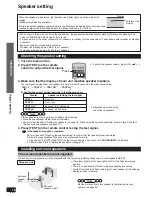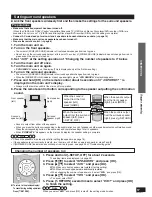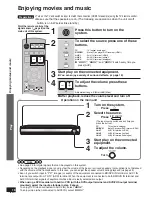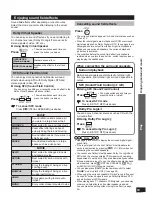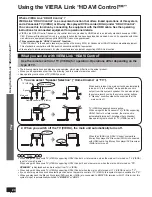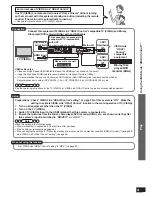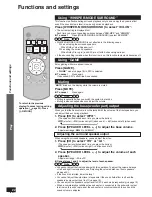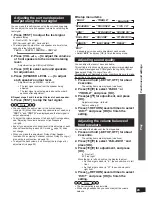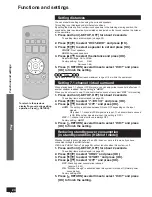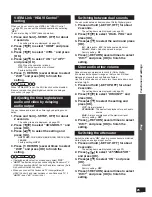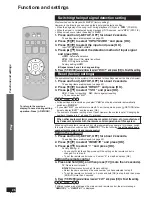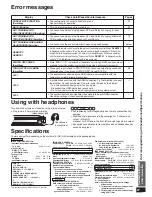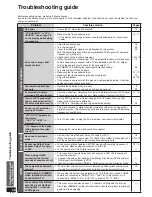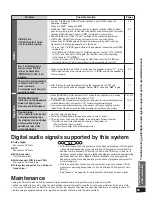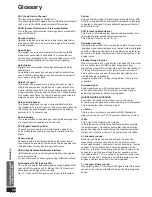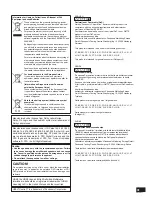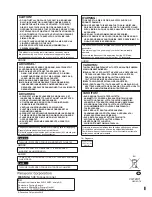
VQT2R71
30
Glossary
Optical
Using optical
fi
bre cable for digital signal input/output from DVD,
CD, etc., provides better sound quality for playback or recording
compared to analogue. Only possible with equipment that has
an optical terminal.
PCM (Pulse Code Modulation)
This is one of the methods that enable analogue sounds to be
converted to digital sounds without compression.
This method is used for music CD, etc.
Sampling frequency
Sampling is the process of converting the heights of sound wave
(analogue signal) samples taken at set periods into digits (digital
encoding). Sampling frequency is the number of samples taken
per second, so larger numbers mean faithful reproduction of the
original sound.
Standby through function
When this system and TV and Blu-ray Disc player/DVD recorder
etc. are connected with HDMI cables, image/audio from
Blu-ray Disc player/DVD recorder etc. can still be transmitted to
TV through this system even though the system is turned off.
This is useful when you want to enjoy late night viewing only
with the television’s speakers.
Images recorded with x.v.Colour, Deep Colour or 3D are also
supported.
Surround signal
Audio signal made up with front speakers, center speaker
and surround speakers. For this system, surround signal is
automatically played by Dolby Virtual Speaker.
WHISPER-MODE SURROUND
Even when the sound volume level is low, you can enjoy
dynamic surround playback similarly as during normal playback.
This is convenient when listening at night.
x.v.Colour
This is a name of products compliant with ISO Standard for
wider colour space: “xvYCC”. This system supports x.v.Colour.
1080p
This is one of the digital hi-vision images.
1080 is the number of effective scanning lines that constitute
the actual screen. This enables every detail to be beautifully
expressed. Images are less
fl
ickered with progressive method
that scans in order from the top. This system supports 1080p.
5.1-channel surround
Monaural and stereo use one channel and two channels
respectively to reproduce sound, but 5.1-channel surround
uses 5 speakers and 1 subwoofer. The 5 channels are: 1 center
speaker, 2 front speakers, and 2 surround speakers at the
side of or to the rear of the sitting position. Sound output of the
subwoofer is much narrower than the other speakers, and so
is considered as 0.1. This is called 5.1-channel surround when
played through all 5.1 channels, and with this system you can
achieve a similar effect with Dolby Virtual Speaker.
7.1-channel virtual surround
When playing back 7.1-channel LPCM signals with this function,
you can enjoy wider sound
fi
eld effects as if another speaker is
added.
ARC (Audio Return Channel)
This function was added to HDMI Ver.1.4.
This sends digital audio signals from the HDMI input terminal of
the TV, etc. to the HDMI output terminal of this system.
CPPM (Content Protection for Prerecorded Media)
This is the copyright protection technology which prevents
fi
le
copy of DVD audio.
Decoder, Decode
Decoder is the device to enable us to hear audio data that is
encoded on DVD, etc., as a normal audio signal. This process
is called Decode.
Deep Colour
This system can reproduce greater colour gradation (4096
steps) when connected to compatible TV and recorder etc.
You can enjoy exceptionally rich, natural-looking colours, with
smooth, detailed gradation and minimal colour banding.
Dolby Digital
Digital sound compression technology developed by Dolby
Laboratories.
Compatible with surround sound as well as 2-channel stereo
sound. With this technology, you can keep massive amount of
audio data in a disc ef
fi
ciently.
Dolby Pro Logic
This system can process not only Dolby Surround, but also
other 2-channel sources to produce a 5.1-channel sound for
a more realistic sound
fi
eld. It is also possible to enhance old
movies recorded in stereo with this dynamic 5.1-channel sound.
This system uses Dolby Pro Logic to add surround effects to
stereo sources such as video cassettes and CDs.
Dolby Virtual Speaker
This system allows you to enjoy a surround effect with two
front speakers. This is not merely a “virtual surround” effect, but
rather uses the optimal speaker arrangements and listening
positions for 5.1-channel sound.
Down-sampling
This is the process of resampling by reducing the sampling rate
of a signal that was sampled at a certain rate.
DTS (Digital Theater Systems)
Surround system used in most movie theatres. Separation
works well between channels, resulting in realistic surround
effects.
Dynamic range
Dynamic range is the difference between the lowest level of
sound that can be heard above the noise of the equipment and
the highest level of sound before distortion occurs.
HDMI (High De
fi
nition Multimedia Interface)
HDMI enables you to transmit digital audio and video signals
using a single cable.
You can also transmit control signals using HDMI connections.
Multi-channel LPCM (Linear PCM)
This is the uncompressed audio signal encoded digitally. Multi-
channel LPCM signals used for Blu-ray Disc, DVD audio, etc.
offer playback with higher-sound quality.
Up to 7.1-channel LPCM signals can be input to this system.
Glossary
Troubleshooting and
other information

